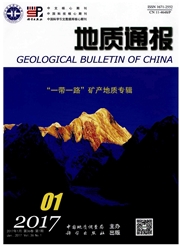

 中文摘要:
中文摘要:
北羌塘中部晚石炭世地层,尤其是晚石炭世晚期地层是否存在,长期以来缺少确凿的古生物化石证据。1∶25万区域地质调查工作对该区石炭系的研究取得了突破,建立了瓦垄山组,划分了6个类化石带,时代为早石炭世晚期至晚石炭世晚期,但缺少Protriticites与Triticites之间的Montiparus带。针对这一问题,对瓦垄山组命名剖面北侧的剖面进行了测制,发现了丰富的Montiparus属和Triticites属的分子,从而为北羌塘中部晚石炭世晚期地层的存在提供了翔实确切的类化石证据。蜓
 英文摘要:
英文摘要:
It has been contentious whether the late Carboniferous rocks, especially the late late Carboniferous rocks were deposited in the central part of northern Qiangtang of Tibet mainly because of the lack of irrefutable biological fossils. An important progress was made by the 1:250000 geological survey, through which the Walongshan Formation was established. The six recognized fusulinid zones show that the Walongshan formation ranges from the late early Carboniferous through the late late Carboniferous. However, in the survey work, the Montiparus zone located between Protriticites and Triticites was blanked. To exactly reflect the fusulinid aspects, another section closely north to the Walongshan defined section was measured and sampled. Abundant Montiparus and Triticites are newly discovered. These findings inform to us that the unquestioned late late Carboniferous rocks were deposited in the central part of the northern Qiangtang, Tibet.
 同期刊论文项目
同期刊论文项目
 同项目期刊论文
同项目期刊论文
 期刊信息
期刊信息
